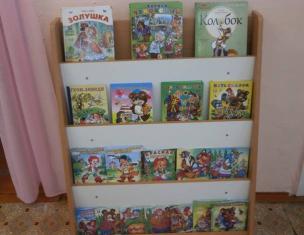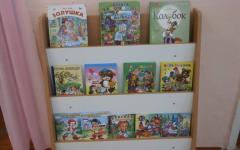The abstract of the lesson on decorative and applied art on the topic "Weaving indoor flower" Poinsettia ".
Author: Chubik Valentina Vyacheslavna, Pedagogue of additional education
Place of work: Center for extracurricular work "Alet", Kaynar children's courtyard club, Kokshetau
Purpose: Formation of students' knowledge and skills for the manufacture of indoor flower from Bead Poinsettia.
Tasks:
Educational:
- To acquaint with needle weaving, weaving loops, parallel weaving and French weaving from beads; explain colors manufacturing stages;
- learning to create more complex elements;
Developing:
- Develop figurative thinking, creative independence, memory, imagination, attention, fine motor skills, cause a desire to fantasize.
Educational:
- educate, personal qualities accuracy, perfection, responsibility.
Type of lesson: lesson studying a new material.
Form of work: frontal, individual, steam room.
Equipment and visual manuals: computer, electronic presentation, scissors, finished products, beads, wire, technological maps.
During the classes.
1. Organizational moment. (3 min.)
- greeting;
- check attendance;
- Checking the preparedness for the lesson.
2. Valerological moment. (2 minutes.)
Purpose: Creating an environment of psychological comfort in class, loss of tension.
The teacher invites children to imagine that they are leaflets that swing on the weak blow of the wind. Children sit comfortably, closing their eyes, relax the muscles of the hands and legs, shaking them. Then students open their eyes and smile a neighbor on the desk. Caused after change, the guys are included in the lesson.
3. Formulation of the theme and objective of the lesson. (5-7 min.)
Teacher: And I want to start an occupation with the poem S. Ya. Marshak. (Quiet music sounds)
No in the world nothing more gentle and more
Than this bundle of petals
Discontinted dislike bowl,
How beautiful it is cold and clean
Dark green, on the edges of the toothed,
For the petal comes petal.
And they all their purple cloth
The inexhaustible stream flows.
Flowers are strange creatures of nature. They blurted out on our planet, long before the emergence of the most remote ancestors of man.
Isn't it surprising that after a half hundreds of millions of years old flowers turned out to be the embodiment of grace and beauty for people?
- Probably you guessed, what will we talk about in class? (your assumptions)
- Correct about the colors and not just about the colors, but about the colors made with their own hands.
- Tell me, what role are the flowers play in a person's life? (Answers Guys)
Many joy bring flowers to people. They give a good mood, they will fantasy, revive and decorate our home.
4. The introductory word of the teacher. (5 minutes.)
Teacher:Now we are ready to pay a lot of money to hold in your hands. This is a short-lived perfection in the form of an Astra inflorestection or rose bud.
With their help, we express our good feelings and movements of the soul - love, appreciation, loyalty. And now I want to show you Flowers made of beads (using VIDOROLIKA)
In the hands of a man, the flowers turned out to be an inexhaustible source of new unusual forms and unexpected combinations of paints. Tens of thousands of varieties and varieties of colors are bred in the world. Approximately the situation is also with decorative colors, or rather with structures that often resemble the forms of real living colors. People who are fascinated by the art of making ornamental colors are not trying to copy nature. From beads, fishing rods and wires skillful fingers can be removed, dozens of variety of products that can be conventionally called flowers
The appointment of them, however, is completely the same - they are called upon to please our eyes, cause good feelings.
- Speaker, and where can flowers from beads be used? (Answers Guys)
5. Explanation of the new material. (7-10 min.)
Methods and techniques for weaving flowers from beads
The main techniques that are used for weaving is needle, looped, parallel and French. Consider every technique in more detail.
Needle weaving
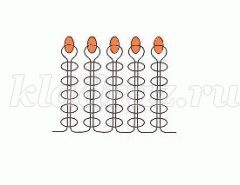
Easy beadwork technique. Needle weaving is used to make single beads from beads. Perfect for the flower stamens.
1. Take a thin wire, and put the required amount of beads on it.
2. Slide beads to the middle of the wire and fold the wire in half.
3. Depending on the magnitude of the stamens, skip the wire from the 2nd or 4th beverage to the wire to the very end through the entire bead column.
4. Both end of the wire binding among themselves.
Weaving loops
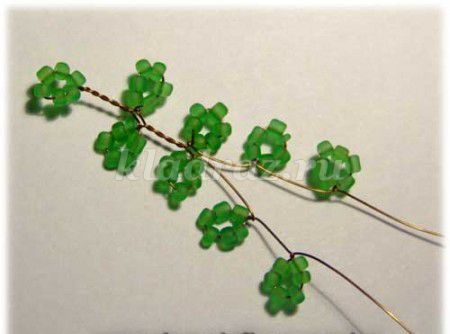
Weave loops is a very simple beadwork technique. It can be used for weaving small petals or leaves. This method of weaving is widely used for bead trees. Since small loops are very similar to tree leaves. Weave the loops in the following way.
1. We take the wire of the desired length and ride the beads to it so that he sat freely.
2. Cut the loop, leaving on the loop the desired amount of beads.
3. After each loop, the wire is twisted several times to secure the loop.
Parallel weaving
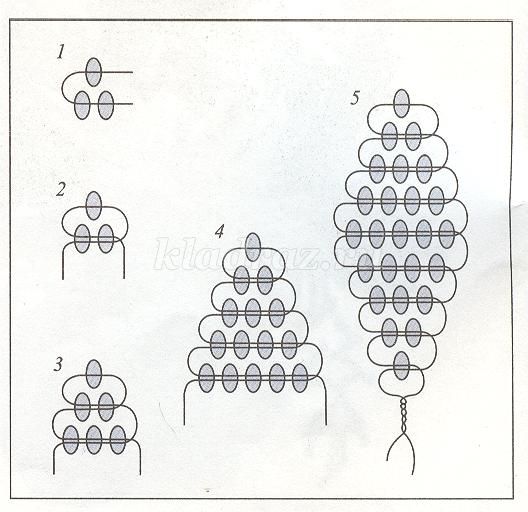
Parallel beads with beads is a more complicated technique. You can do both flat and volumetric flowers in this technique. Parallel weaving is used for weaving flower petals and leaves. The peculiarity of this technique is that the element rows from top to bottom, each series is performed in series.
Consider a parallel weaving on the example of the petal.
Formula 1-1-2-4-4-4-3-2. This means how much bisper is necessary for each row of the petal. In our case, we have 8 rows. Take wire 12 "(30cm).
Row 1. We ride 1 bisery. I slide it until the middle of the wire. Moving the wire in half.
Row 2. On the right side of the wire we ride 1 beerin. We stretch through the bisper on the left side the left part of the wire.
Row 3. On the right side of the wire we ride 2 bispers. And through the whole range, stretch the left part of the wire.
A series 4. We ride on the right side of the 4 bispers and the second part of the wire stretch through the whole range. Center the fourth row relative to the third. Rows 5 and 6 also perform as 4 row.
A number 7. We recruit 3 bispers on the right side and skip the other end of the wire through them. Center a number of relative to the previous series.
Row 8. We recruit the wire of 2 bispers to one end and skip the second end of the wire through them. Cut the ends of the wire to fix the beads. Our petal is ready.
If it is necessary to connect the petals among themselves in the lower 6, 7, 8 rows. We are wearing subsequent petals according to the scheme, when we reach the 6th row from the connection side we cling our working wire, which came out of the 5th row of beads, through the side loops of the previous petal. We also do this compound also in 7 and 8 rows.
French weaving
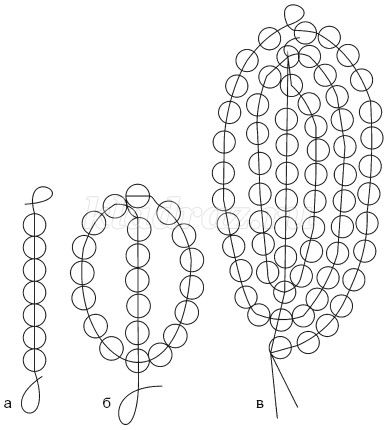
French beading is a very common technique. It is also used as a parallel weaving for the manufacture of leaves and petals. This is quite simple weaving, which is often used for weaving colors.
1. Make the rod sheet. We recruit the required amount of beads. In our example, 9 pieces. At the end of the wire, we make a loop that will prevent the loss of beads from the rod.
2. At the end of the bead column, we fix a long piece of wire on the rod, to which we ride 1 circular row of beads according to the diagram (11 of the beads). Watch the wire around the rod, tightly pressing beads to the rod.
3. We recruit 2 row of beads (11 beads). Watch the wire around the rod, tightly pressing beads to the rod.
4. We recruit 3 row of beads (15 beads). Watch the wire around the rod, tightly pressing beads to the rod.
5. We recruit 4 row of beads (15 beads). Watch the wire around the rod, tightly pressing beads to the rod.
6. Unwind the upper loop on the rod and pass it into the last row. The residue is cut.
Stages work on flower.
1. Weaving petals.
2. Weaving stamens.
3. Weaving leaves.
4. Build a flower.
5. Weaving the desired amount of colors and compiling a bouquet.
6. Fizminutka. (2 minutes.)
"Flowers"
Once - three-three flowers rose (squatted, get up)
To the Sun stretched high: (stretch on the socks)
It became nice and warm! (watch up)
The breeze flew, the skeleton shook (they swing to the left - right above his head)
Left swung - low rusted. (leaving left)
Right swung - lowered low. (leaning right)
The breeze run away! (threaten with your finger)
You do not break the flowers! (Sat)
Let them grow, grow,
Children joy will bring! (slowly lifting hands up, open fingers).
7. Practical work. Production of the indoor flower "Puancetia".
7.1 introductory instruction. (2 minutes.)
Safety regulations when working with beads
1. Dangers in the work: damage to the fingers wire; Hand injury with scissors; Eye injury.
2. What needs to be done before starting work: put the tools and devices in the place allotted for them.
3. What you need to do while working: be attentive to work; put the scissors to the right with closer blades directed from themselves; Transmit scissors only with closed blades and rings forward. You can not cut on the go. When working with scissors, it is necessary to monitor the movement and position of the blades during operation.
4. What needs to be done at the end of the work: to calculate the number of needles and pins in the needle. They should be as much as it was at the beginning of work; Remove the workplace.
5. Follow the posture, do not harb.
7.2 Performing practical work and current instruction. (10-15 min.)
- Name the stages of work on the flower? View presentation.
- What traditions must be observed in work? Accuracy, patience, conscientiousness, correctness.
Weaving product technology card.
In case of difficulty in individual students, a mutual assistance is possible.
7.3 Teacher targets.
-Control organization of the workplace.
-Control the correctness of the performance of work techniques and compliance with the rules of safe work.
- Assigning assistance to students experiencing difficulties.
Contination of the volume and quality of performance.
7.4 Final instruction (2 min.)
The guys are pronouncing which mistakes in general were allowed when performing a task and together with the teacher are looking for ways to solve.
8. Reflection (5 min.)
"Compliment":
Compliment - praise.
Compliment to business qualities.
A compliment in the feelings in which students assess each other's contribution to the classroom.
This version of the end of the lesson makes it possible to satisfy the need to recognize the personal significance of each.
9. Summing up (2 min.)


